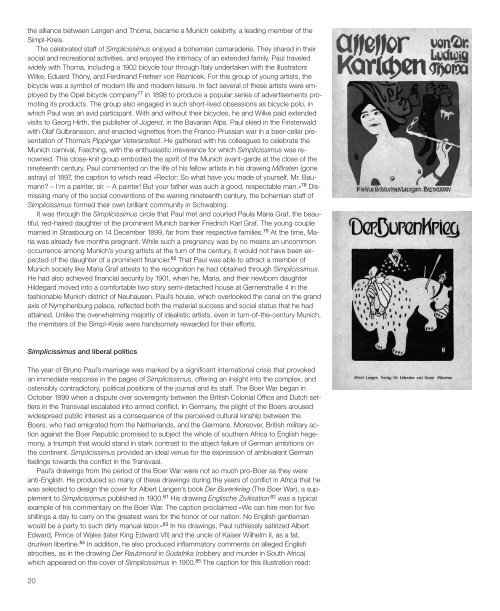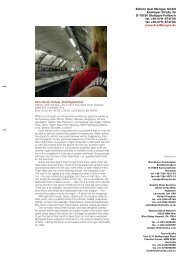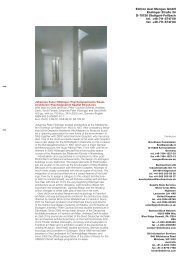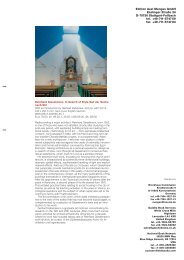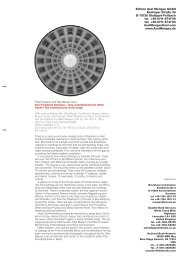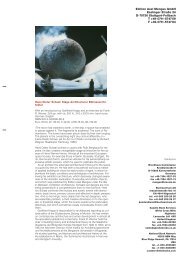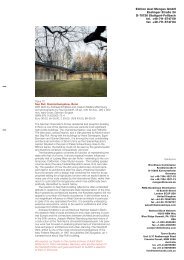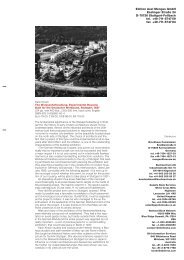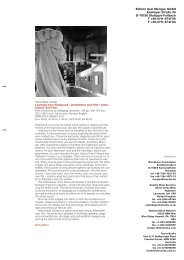Bruno Paul - Edition Axel Menges
Bruno Paul - Edition Axel Menges
Bruno Paul - Edition Axel Menges
Create successful ePaper yourself
Turn your PDF publications into a flip-book with our unique Google optimized e-Paper software.
the alliance between Langen and Thoma, became a Munich celebrity, a leading member of the<br />
Simpl-Kreis.<br />
The celebrated staff of Simplicissimus enjoyed a bohemian camaraderie. They shared in their<br />
social and recreational activities, and enjoyed the intimacy of an extended family. <strong>Paul</strong> traveled<br />
widely with Thoma, including a 1902 bicycle tour through Italy undertaken with the illustrators<br />
Wilke, Eduard Thöny, and Ferdinand Freiherr von Reznicek. For this group of young artists, the<br />
bicycle was a symbol of modern life and modern leisure. In fact several of these artists were employed<br />
by the Opel bicycle company 77 in 1898 to produce a popular series of advertisements promoting<br />
its products. The group also engaged in such short-lived obsessions as bicycle polo, in<br />
which <strong>Paul</strong> was an avid participant. With and without their bicycles, he and Wilke paid extended<br />
visits to Georg Hirth, the publisher of Jugend, in the Bavarian Alps. <strong>Paul</strong> skied in the Finsterwald<br />
with Olaf Gulbransson, and enacted vignettes from the Franco-Prussian war in a beer-cellar presentation<br />
of Thoma’s Pippinger Veteransfest. He gathered with his colleagues to celebrate the<br />
Munich carnival, Fasching, with the enthusiastic irreverence for which Simplicissimus was renowned.<br />
This close-knit group embodied the spirit of the Munich avant-garde at the close of the<br />
nineteenth century. <strong>Paul</strong> commented on the life of his fellow artists in his drawing Mißraten (gone<br />
astray) of 1897, the caption to which read »Rector: So what have you made of yourself, Mr. Baumann?<br />
– I’m a painter, sir. – A painter! But your father was such a good, respectable man.« 78 Dismissing<br />
many of the social conventions of the waning nineteenth century, the bohemian staff of<br />
Simplicissimus formed their own brilliant community in Schwabing.<br />
It was through the Simplicissimus circle that <strong>Paul</strong> met and courted <strong>Paul</strong>a Maria Graf, the beautiful,<br />
red-haired daughter of the prominent Munich banker Friedrich Karl Graf. The young couple<br />
married in Strasbourg on 14 December 1899, far from their respective families. 79 At the time, Maria<br />
was already five months pregnant. While such a pregnancy was by no means an uncommon<br />
occurrence among Munich’s young artists at the turn of the century, it would not have been expected<br />
of the daughter of a prominent financier. 80 That <strong>Paul</strong> was able to attract a member of<br />
Munich society like Maria Graf attests to the recognition he had obtained through Simplicissimus.<br />
He had also achieved financial security by 1901, when he, Maria, and their newborn daughter<br />
Hildegard moved into a comfortable two story semi-detached house at Gernerstraße 4 in the<br />
fashionable Munich district of Neuhausen. <strong>Paul</strong>’s house, which overlooked the canal on the grand<br />
axis of Nymphenburg palace, reflected both the material success and social status that he had<br />
attained. Unlike the overwhelming majority of idealistic artists, even in turn-of-the-century Munich,<br />
the members of the Simpl-Kreis were handsomely rewarded for their efforts.<br />
Simplicissimus and liberal politics<br />
The year of <strong>Bruno</strong> <strong>Paul</strong>’s marriage was marked by a significant international crisis that provoked<br />
an immediate response in the pages of Simplicissimus, offering an insight into the complex, and<br />
ostensibly contradictory, political positions of the journal and its staff. The Boer War began in<br />
October 1899 when a dispute over sovereignty between the British Colonial Office and Dutch settlers<br />
in the Transvaal escalated into armed conflict. In Germany, the plight of the Boers aroused<br />
widespread public interest as a consequence of the perceived cultural kinship between the<br />
Boers, who had emigrated from the Netherlands, and the Germans. Moreover, British military action<br />
against the Boer Republic promised to subject the whole of southern Africa to English hegemony,<br />
a triumph that would stand in stark contrast to the abject failure of German ambitions on<br />
the continent. Simplicissimus provided an ideal venue for the expression of ambivalent German<br />
feelings towards the conflict in the Transvaal.<br />
<strong>Paul</strong>’s drawings from the period of the Boer War were not so much pro-Boer as they were<br />
anti-English. He produced so many of these drawings during the years of conflict in Africa that he<br />
was selected to design the cover for Albert Langen’s book Der Burenkrieg (The Boer War), a supplement<br />
to Simplicissimus published in 1900. 81 His drawing Englische Zivilisation 82 was a typical<br />
example of his commentary on the Boer War. The caption proclaimed »We can hire men for five<br />
shillings a day to carry on the greatest wars for the honor of our nation. No English gentleman<br />
would be a party to such dirty manual labor.« 83 In his drawings, <strong>Paul</strong> ruthlessly satirized Albert<br />
Edward, Prince of Wales (later King Edward VII) and the uncle of Kaiser Wilhelm II, as a fat,<br />
drunken libertine. 84 In addition, he also produced inflammatory comments on alleged English<br />
atrocities, as in the drawing Der Raubmord in Südafrika (robbery and murder in South Africa)<br />
which appeared on the cover of Simplicissimus in 1900. 85 The caption for this illustration read:<br />
21. Cover for Ludwig Thoma’s Assessor Karlchen,<br />
1901.<br />
23. Am Ziel (At the Destination), 1898. Advertisement<br />
for Opel bicycles and Henkell Sekt published<br />
in the magazine Über Land und Meer.<br />
22. Cover for Der Burenkrieg, 1900.<br />
24. Der Raubmord in Südafrika (Robbery and Murder<br />
in South Africa), 1900. »(The Queen) Don’t<br />
worry Joe, those men back there won’t disturb us,<br />
they’re my relatives!«<br />
(The Queen:) »Don’t worry Joe, those men back there won’t disturb us, they’re my relatives!« 86<br />
The Joe in the drawing, a lanky figure brandishing a long knife, was British Colonial Secretary<br />
Joseph Chamberlain. The man in the background wearing a Cossack hat was Nicolas II, Czar<br />
of Russia. The figure in a Pickelhaube, the spiked Prussian helmet, was Wilhelm II. 87 Queen Victoria’s<br />
personal and military domination of her Prussian grandson was at the crux of the anti-English<br />
sentiment of Simplicissimus, and of <strong>Paul</strong>’s vitriolic illustrations concerning the war in Africa.<br />
Though Simplicissimus supported the strength and independence of the German government<br />
with respect to international affairs and the Kaiser’s independence of his grandmother’s policies,<br />
the position of the journal regarding internal politics was distinctly different. Throughout its history,<br />
Simplicissimus was consistently critical of the military, the bureaucracy, the power of the church,<br />
and the excesses of the capitalist elite. As a consequence, the journal was associated with the<br />
political left. During the first years of the twentieth century the political right in Bavaria was dominated<br />
by the moralistic and conservative policies of the military and the power of the hereditary<br />
monarchy. The contemporary Zentrumspartei (center party) was both religious and particularistic,<br />
and sponsored repressive policies such as the notorious Lex Heinze of 1900. This law, named<br />
for a Berlin pimp, was intended to counter the morally destructive influence of a broadly defined<br />
pornography. As originally written, the law would have imposed harsh punishments upon graphic<br />
artists and playwrights whose work was deemed to be obscene. In light of the obtrusive policies<br />
of the ostensible center, it was inevitable that the Munich Modernists, and particularly the circle<br />
responsible for the pervasive eroticism of Jugend, should be driven to the left. <strong>Paul</strong> summarized<br />
his own opposition to the Lex Heinze and its supporters with his drawing Der Cylinderhut als<br />
Feigenblatt (the top hat as fig leaf) of 1900. 88 He was clearly provoking the censors with this<br />
drawing, and the obvious double entendre that it contained. But Der Cylinderhut als Feigenblatt<br />
was printed amidst a deluge of satirical commentary on the Lex Heinze that appeared in the<br />
pages of Simplicissimus and other popular publications during 1900, and <strong>Paul</strong>’s provocation went<br />
unanswered. Nevertheless opposition to the Lex Heinze was sufficiently widespread to prevent<br />
passage of the legislation in its original form, largely as a consequence of the efforts of <strong>Paul</strong> and<br />
other avant-garde artists to draw popular attention to what would have otherwise been an obscure<br />
legal proceeding. He played an active role in opposing the policies of the right concerning<br />
the Boer War and of the center concerning the Lex Heinze. Ironically, he was equally successful<br />
in his opposition to the policies of his own employers.<br />
In his memoirs, <strong>Paul</strong> noted that while on the staff of Simplicissimus he and Thomas Theodor<br />
Heine had been supporters of »international« and »radical«, that is to say socialist, politics. 89<br />
Heine was, in fact, internationally regarded as a »rabid social democrat«. 90 Yet the most radical<br />
political action in which <strong>Paul</strong> actively participated during his years in Munich occurred within the<br />
offices of Simplicissimus, when in 1906 the staff of the journal disputed the absolute authority<br />
wielded by Langen. The artistic contributors threatened to establish their own, competing publication<br />
if Langen did not offer to share a percentage of the profits earned by the journal. The editor<br />
relented, reestablishing his magazine as a corporation. <strong>Paul</strong> and his coworkers each invested<br />
1400 Marks in Simplicissimus GmbH to become shareholders in the new company. 91 The reorganization<br />
of Simplicissimus represented a shrewd and profitable commercial undertaking by its<br />
staff. Wherever <strong>Paul</strong>’s political sympathies lay in 1906, he himself had become a successful capitalist<br />
with an income sufficient to establish himself in a comfortable, middle-class life. 92<br />
Modern graphic art and modern life<br />
The spirit of reform that <strong>Paul</strong> and his fellow members of the Munich avant-garde promoted was<br />
not confined to individual disciplines, but rather embraced the Jugendstil ideal of the Gesamtkunstwerk:<br />
the total work of art. Modern art, modern politics, modern work, modern dress, and<br />
modern theater were all perceived as facets of the Gesamtkunstwerk of modern life that was the<br />
ultimate goal of the Munich reformers. As a member of this avant-garde, <strong>Paul</strong>’s own artistic efforts<br />
quickly assumed the same interdisciplinary character as the broader movement, a trend that<br />
would have significant consequences for his later career.<br />
Soon after joining the staff of Simplicissimus, <strong>Paul</strong> began preparing graphic designs for firms<br />
that advertised in the journal, or were otherwise supportive of Munich’s progressive artists. An<br />
early logotype for the printers Michael Huber, completed by 1898, epitomized these designs. It<br />
was an exemplary expression of the Jugendstil, combining type design, painterly representation,<br />
and purely abstract composition. The serpent in the composition recalled his earliest graphic de-<br />
20 21


